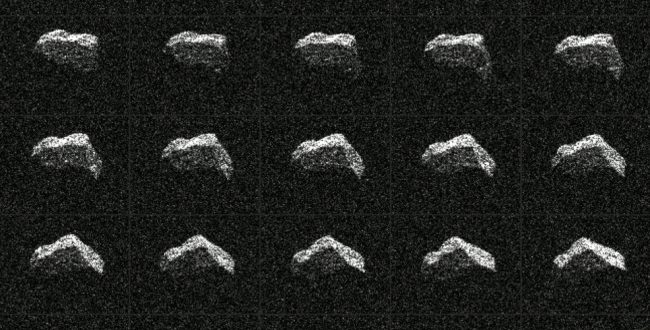Asteroid 2017 BQ6 safely flew past Earth on Feb. 6 at about 6.6 times the distance of Earth to the moon.
To radar imager Lance Benner at JPL in Pasadena, asteroid 2017 BQ6 resembles the polygonal dice used in Dungeons and Dragons. But my eyes see something closer to a stepping stone or paver you’d use to build a walkway. However you picture it, this asteroid is more angular than most imaged by radar.
It flew harmlessly by Earth on Feb. 7 at 1:36 a.m. EST (6:36 UT) at about 6.6 times the distance between Earth and the moon or some about 1.6 million miles. Based on 2017 BQ6’s brightness, astronomers estimate the hurtling boulder about 660 feet (200 meters) across.
“The radar images show relatively sharp corners, flat regions, concavities, and small bright spots that may be boulders,” said Lance Benner of NASA’s Jet Propulsion Laboratory in Pasadena, California, who leads the agency’s asteroid radar research program. “Asteroid 2017 BQ6 reminds me of the dice used when playing Dungeons and Dragons. It is certainly more angular than most near-Earth asteroids imaged by radar.”
Asteroid 2017 BQ6 safely passed Earth on Feb. 6 at 10:36 p.m. PST (1:36 a.m. EST, Feb. 7) at about 6.6 times the distance between Earth and the moon (about 1.6 million miles, or 2.5 million kilometers). It was discovered on Jan. 26 by the NASA-funded Lincoln Near Earth Asteroid Research (LINEAR) Project, operated by MIT Lincoln Laboratory on the Air Force Space Command’s Space Surveillance Telescope at White Sands Missile Range, New Mexico.
Radar has been used to observe hundreds of asteroids. When these small, natural remnants of the formation of the solar system pass relatively close to Earth, deep space radar is a powerful technique for studying their sizes, shapes, rotation, surface features, and roughness, and for more precise determination of their orbital path.
Agencies/Canadajournal
 Canada Journal – News of the World Articles and videos to bring you the biggest Canadian news stories from across the country every day
Canada Journal – News of the World Articles and videos to bring you the biggest Canadian news stories from across the country every day



